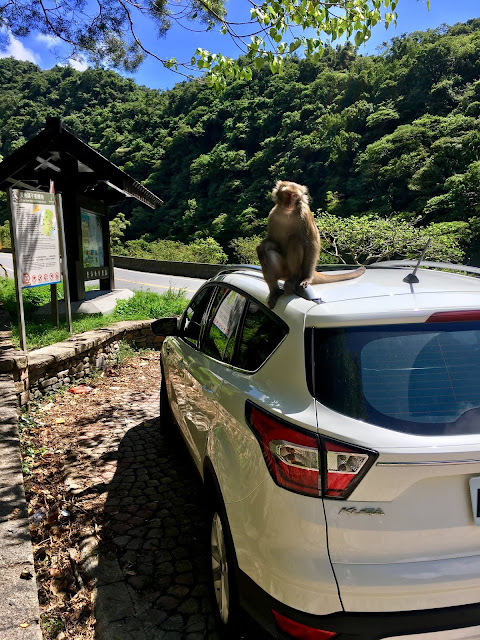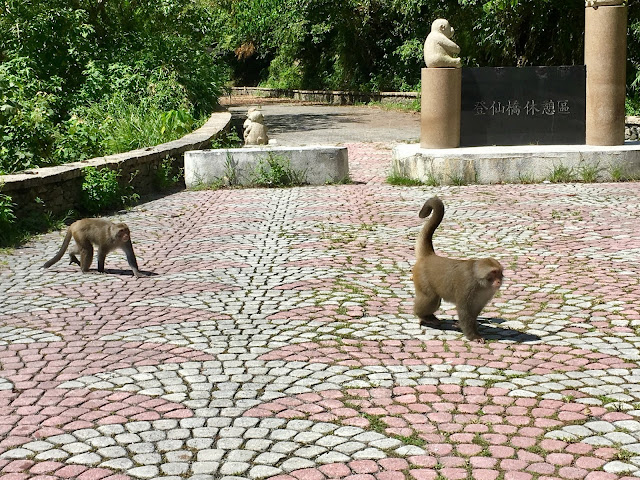Travel Date: 2019/08/31-09/02
t's our last day in Taitung (we only stayed here for 2 days), and tomorrow we're heading to Hualien. Thanks to my husband's uncle, we've visited some places that most local people would go to and discovered many shortcuts that Google Maps would never show you. Unfortunately, one day it rained heavily, so we could only visit the museum. The road to Hualien is filled with many attractions along the coastal area. We hope to see as many as possible, but we also had to cancel some of our plans due to lack of time.
Seeing wild monkeys was a first-time experience for me. We went there twice because the weather was too bad on the first day. A monkey followed me, and I got scared and quickly jumped into the car. Unfortunately, the animal sat on our car's roof, doors, mirrors, and so on.
The east coast is very beautiful, but unfortunately, we didn't have a chance to go to the beach. Usually, we made quick stops at many nearby places to see as much as possible.
Donghe Village (泰源幽谷)
From Donghe Bridge, along the Dongfu Highway into the coastal mountains, you can reach the famous Taiyuan Valley. It is surrounded by mountains and eroded by rivers, forming a canyon terrain.
Taiyuan Valley is also a paradise for Taiwanese macaques. Monkeys can often be seen in the woods or directly approaching tourists for food, creating a unique scenery. It is the best place to enjoy monkeys in Taitung, adding more to the journey.
Monkeys are easily seen near the bridge in the area. Be careful and don't take anything out of your car, as they will chase you. It's just a quick stop, not far from the main coastal road.
Donghe Township has an old name, Fafukod (馬武窟), which means "fishing by net" in the Ami language. Many prehistoric artifacts have been found at the Dulan Site. In 1920, during Japanese rule, the Toran local office was established. In 1937, it was changed to Toran Village (都蘭庄) under Shinkō District (新港郡), Taitō Prefecture. The name "Donghe Township" was established after World War II and is currently used.
Newer post from Donghe: HERE
金樽陸連島
The Jinyu Recreation Area consists of a small bay, an offshore reef, a long sandy beach, and a coastal cliff. The bay is shaped like a wine glass and is called "Golden Dragonfly." Jinmao has a 3km stretch of soft beaches.
Amis Folk Center (阿美族民俗中心)
The Ami Folk Center is located next to the headquarters of the East Tube Office and covers an area of about 2 hectares. It features outdoor performance plazas, outdoor stands for 2,000 people, archery experience areas, Ami traditional houses, and more. Visitors can engage in DIY activities like making Ami beading or traditional instrumental flutes, or enjoy Ami traditional song and dance performances. It offers a chance to experience Ami culture and have fun with parents and children.
The Ami Folklore Center was completed in November 1995. The main building's sacred houses and homes were hand-painted according to the Japanese ethnologist Qian Qianyan. They imitated the priests of the Taiba Bengshe in Hualien County to build a home. Visiting here allows you to witness the unique living culture of the Ami.
Ami traditional houses are mostly made of thatch. In addition to visiting the famous buildings and understanding the beauty of Ami architecture, the folk center also features tribal cultural relics exhibitions, handicrafts, special product exhibitions, and food services.
The Ami ethnic group is located east of the Liwu River and the east coast of the East Coast. It has a population of about 140,000 and is the most populous group among Taiwan's aboriginal people. The Ami still retains a rich traditional culture. The Harvest Festival is the most representative traditional ritual. It is held every summer to celebrate the harvest of millet, offer sacrifices to ancestors and gods, and express gratitude. The ceremony is full of blessings and emphasizes the ethics of pursuing the future and unity.
Since the Ami society is predominantly matriarchal, the ideal Ami family house is long and wide, with a capacity of about 20 people. Ami traditional houses are mostly made of thatched roofs, wooden pillars, vertical bamboo side walls, and indoor rattan-woven elevated beds. Generally, houses usually need to be rebuilt after more than ten years of residence. The thatch on the roof needs to be replenished every year, and replacement is required every three to four years.
In the Ami language, it is called "Paong'ong." There are two explanations for the origin of the place name. One is related to the nearby Kanatoron Creek and Chiinawan Creek. The Ami people call it "paongowan." The other explanation is that the area has many Papaongay plants. The buds of this plant have refreshing properties and can repel mosquitoes when burned. It is said that children who eat Papaongay's buds perform better in spiritual learning. Over time, the place became known as Paong'ong or Papaongay.
Museum of Natural History (台東縣自然史教育館)
The Taitung County Natural History Education Center displays a collection of 557 shell specimens and features mineral display rooms showcasing marine treasures and ores from around the world. It combines natural resources with educational functions.
The mineral exhibition room on the third floor displays over 200 ore rocks from Hualien and Taitung, including gemstones from the coastal mountains like sapphire. You can observe the contrast between original stones and carved stones.
Taiwan's Lanbao original stone was first unearthed during the Japanese colonial rule. It was discovered by the aborigines in Dulan Mountain. It is a 70-centimeter-long, 30-centimeter-wide, and 30-centimeter-high blue translucent stone that officially unveiled the upsurge of the East Coast Mountains.




















Hello, It looks fantastic! no pollution like in the north..I have not been to Taidong for a decade..it is a shame!
ReplyDeleteYes, Taidong is amazing! I start to miss it as soon as went back home haha the sea and beaches in west of Taiwan are nothing like that
Delete